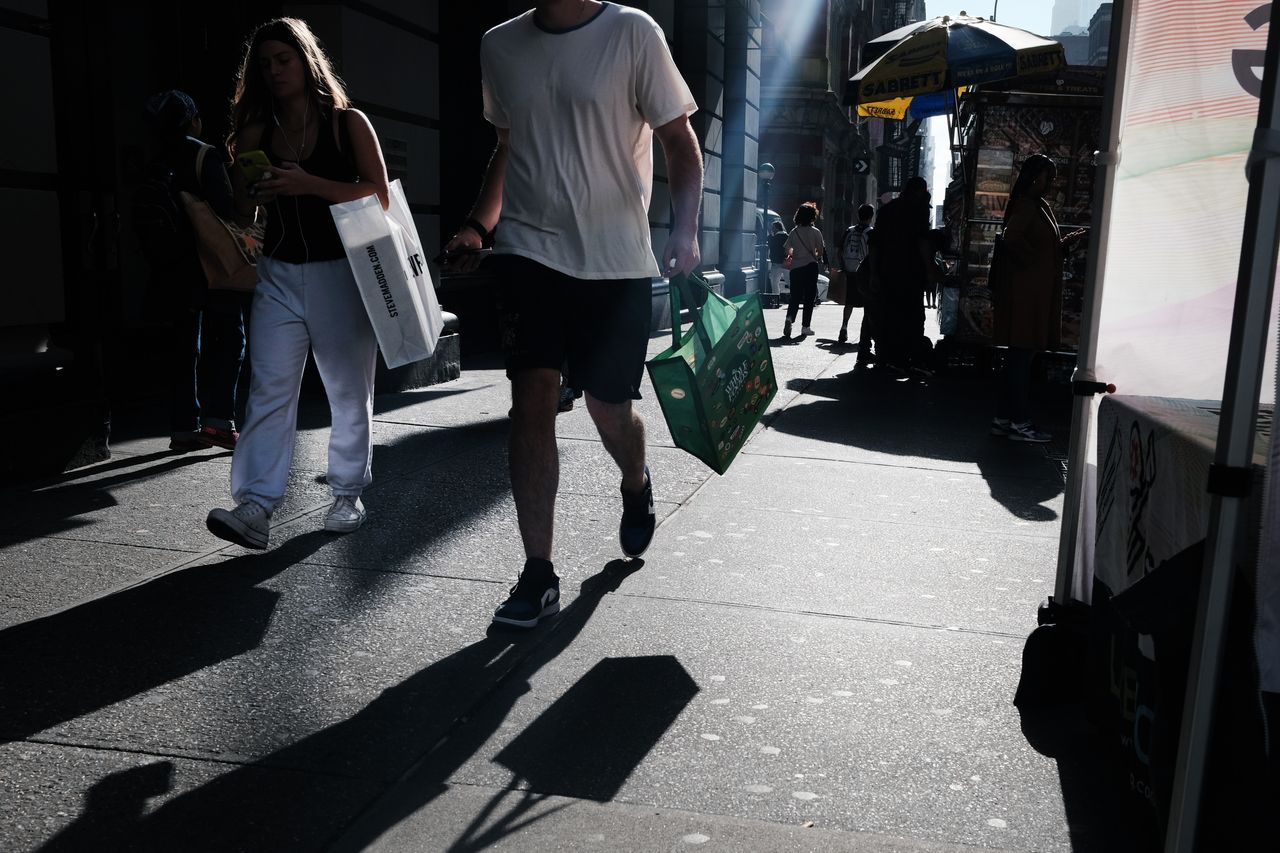The U.S. Economy Grew, but It’s Not as Good as It Looks
The U.S. economy grew at a surprisingly high 2.6% annual rate in the third quarter, reversing two consecutive quarters of declines. But beneath the strong headline number were signs that consumers are feeling the pinch of inflation and that the housing market has been hit by this year’s dramatic rise in interest rates.
Nevertheless, quarterly growth of this magnitude should reassure investors that the U.S. has not, at this point, been plunged into recession. Fears of an economic slowdown have been front of mind this year amid a dramatic tightening of financial conditions by the Federal Reserve. The central bank is attempting to get inflation, which is at its hottest in decades, under control by boosting interest rates.
But one quarter of growth doesn’t mean the risk of a slowdown has passed.
“The trajectory for growth looks weak,” said Jeffrey Roach, the chief economist at LPL Financial. “A deteriorating housing market and nagging inflation along with an aggressive Federal Reserve puts the economy on unsure footing for 2023.”
The market reaction was still upbeat. The Dow Jones Industrial Average was rising 375 points, or 1.2%, on Thursday.
After all, the result was a significant surprise to the upside. Economists surveyed by FactSet had estimated that the economy grew at a 2% annual rate in the three months to the end of September, following declines of 0.6% and 1.6% in the second and first quarter, respectively. The first half of the year marked a technical recession, defined as two consecutive quarters of negative gross domestic product growth.
The rise in third-quarter growth reflected net increases in exports, matching expectations that the trade deficit had narrowed as a result of a steep drop in imports, in part due to bloated inventories at some retailers. It was much fewer imports of consumer goods that led to the overall decline.
International trade dynamics may have been what ultimately delivered such strong growth in GDP, but investors would do well to examine some of the more telling components in the data.
Consumer spending increased overall, reflecting money flowing to healthcare and other services. But shoppers stopped digging as deep in their pockets to purchase goods, with data showing a deceleration of spending on cars, parts, and food and beverages. This was the third straight quarter in which goods spending fell, indicating a squeeze on consumers.
Amid signs that inflation remains persistently high—with two more interest-rate decisions due from the Federal Reserve this year—these trends are important.
As are indications that the U.S. is facing a slowdown in the housing market. GDP growth was primarily weighed down by a decrease in residential housing investment, and especially single-family home construction. The Fed’s hawkish shift on interest rates has had a knock-on effect on the mortgage market and created what some economists have called a housing recession.
The data out Thursday may be as good as it gets for a while.
“We expect 3Q22 to mark the peak in quarterly growth, as the cumulative effect of tighter monetary policy begins to push growth below potential,” said Ellen Zentner, the chief U.S. economist at Morgan Stanley. The bank expects to see GDP growth in the fourth quarter of just 0.8%.
“There’s a distinct possibility that Q3 could be the last hurrah for this post-pandemic economic expansion, as the U.S. faces material economic headwinds as a result of the Fed’s aggressive tightening cycle,” said Michael Reynolds, vice president of investment strategy at Glenmede.
The growth picture is likely to get gloomier as the full impact of the Fed’s monetary policy ripples across the economy—a process that can take many months or a year. The central bank is expected to hike rates by 75 basis points, or three quarters of a percentage point, for the fourth time since June next week. That, and another rate decision in December, will only show up in the data deep in 2023.
By that point, this year’s third quarter likely will look even better.
 Copyright 2020, Dow Jones & Company, Inc. All Rights Reserved Worldwide. LEARN MORE
Copyright 2020, Dow Jones & Company, Inc. All Rights Reserved Worldwide. LEARN MORE
This stylish family home combines a classic palette and finishes with a flexible floorplan
Just 55 minutes from Sydney, make this your creative getaway located in the majestic Hawkesbury region.
As Paris makes its final preparations for the Olympic games, its residents are busy with their own—packing their suitcases, confirming their reservations, and getting out of town.
Worried about the hordes of crowds and overall chaos the Olympics could bring, Parisians are fleeing the city in droves and inundating resort cities around the country. Hotels and holiday rentals in some of France’s most popular vacation destinations—from the French Riviera in the south to the beaches of Normandy in the north—say they are expecting massive crowds this year in advance of the Olympics. The games will run from July 26-Aug. 1.
“It’s already a major holiday season for us, and beyond that, we have the Olympics,” says Stéphane Personeni, general manager of the Lily of the Valley hotel in Saint Tropez. “People began booking early this year.”
Personeni’s hotel typically has no issues filling its rooms each summer—by May of each year, the luxury hotel typically finds itself completely booked out for the months of July and August. But this year, the 53-room hotel began filling up for summer reservations in February.
“We told our regular guests that everything—hotels, apartments, villas—are going to be hard to find this summer,” Personeni says. His neighbours around Saint Tropez say they’re similarly booked up.
As of March, the online marketplace Gens de Confiance (“Trusted People”), saw a 50% increase in reservations from Parisians seeking vacation rentals outside the capital during the Olympics.
Already, August is a popular vacation time for the French. With a minimum of five weeks of vacation mandated by law, many decide to take the entire month off, renting out villas in beachside destinations for longer periods.
But beyond the typical August travel, the Olympics are having a real impact, says Bertille Marchal, a spokesperson for Gens de Confiance.
“We’ve seen nearly three times more reservations for the dates of the Olympics than the following two weeks,” Marchal says. “The increase is definitely linked to the Olympic Games.”

Getty Images
According to the site, the most sought-out vacation destinations are Morbihan and Loire-Atlantique, a seaside region in the northwest; le Var, a coastal area within the southeast of France along the Côte d’Azur; and the island of Corsica in the Mediterranean.
Meanwhile, the Olympics haven’t necessarily been a boon to foreign tourism in the country. Many tourists who might have otherwise come to France are avoiding it this year in favour of other European capitals. In Paris, demand for stays at high-end hotels has collapsed, with bookings down 50% in July compared to last year, according to UMIH Prestige, which represents hotels charging at least €800 ($865) a night for rooms.
Earlier this year, high-end restaurants and concierges said the Olympics might even be an opportunity to score a hard-get-seat at the city’s fine dining.
In the Occitanie region in southwest France, the overall number of reservations this summer hasn’t changed much from last year, says Vincent Gare, president of the regional tourism committee there.
“But looking further at the numbers, we do see an increase in the clientele coming from the Paris region,” Gare told Le Figaro, noting that the increase in reservations has fallen directly on the dates of the Olympic games.
Michel Barré, a retiree living in Paris’s Le Marais neighbourhood, is one of those opting for the beach rather than the opening ceremony. In January, he booked a stay in Normandy for two weeks.
“Even though it’s a major European capital, Paris is still a small city—it’s a massive effort to host all of these events,” Barré says. “The Olympics are going to be a mess.”
More than anything, he just wants some calm after an event-filled summer in Paris, which just before the Olympics experienced the drama of a snap election called by Macron.
“It’s been a hectic summer here,” he says.

AFP via Getty Images
Parisians—Barré included—feel that the city, by over-catering to its tourists, is driving out many residents.
Parts of the Seine—usually one of the most popular summertime hangout spots —have been closed off for weeks as the city installs bleachers and Olympics signage. In certain neighbourhoods, residents will need to scan a QR code with police to access their own apartments. And from the Olympics to Sept. 8, Paris is nearly doubling the price of transit tickets from €2.15 to €4 per ride.
The city’s clear willingness to capitalise on its tourists has motivated some residents to do the same. In March, the number of active Airbnb listings in Paris reached an all-time high as hosts rushed to list their apartments. Listings grew 40% from the same time last year, according to the company.
With their regular clients taking off, Parisian restaurants and merchants are complaining that business is down.
“Are there any Parisians left in Paris?” Alaine Fontaine, president of the restaurant industry association, told the radio station Franceinfo on Sunday. “For the last three weeks, there haven’t been any here.”
Still, for all the talk of those leaving, there are plenty who have decided to stick around.
Jay Swanson, an American expat and YouTuber, can’t imagine leaving during the Olympics—he secured his tickets to see ping pong and volleyball last year. He’s also less concerned about the crowds and road closures than others, having just put together a series of videos explaining how to navigate Paris during the games.
“It’s been 100 years since the Games came to Paris; when else will we get a chance to host the world like this?” Swanson says. “So many Parisians are leaving and tourism is down, so not only will it be quiet but the only people left will be here for a party.”
This stylish family home combines a classic palette and finishes with a flexible floorplan
Just 55 minutes from Sydney, make this your creative getaway located in the majestic Hawkesbury region.






















